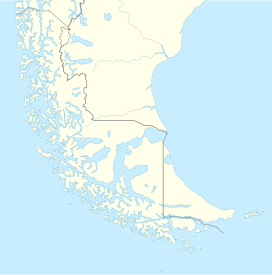Cerro Mayo
| Cerro Mayo | |
|---|---|
 Cerro Mayo. | |
| Highest point | |
| Elevation | 1,816 m (5,958 ft) |
| Geography | |
 | |
| Location | Southern Patagonian Ice Field |
| Country | |
Cerro Mayo[1] or de Mayo is a mountain located in the Southern Patagonian Ice Field, in Santa Cruz Province, Argentina. It is part of Los Glaciares National Park.

Nearby is the Mayo Glacier, which is accessible from the Mayo Bay of Lake Argentino and the Cerro Negro.[2][3]
Chilean cartography considered this mountain to be the true Cerro Stokes, the mountain first sighted by the Fitz Roy expedition and by the surveyors of both countries in the early 20th century (who considered Cerro Cervantes to be Stokes), and it was regarded as a border landmark until the 1998 agreement.[4] Its geographical location has varied on maps over time.[5]
History
[edit]After the signing of the 1881 Treaty between Argentina and Chile, the boundary in the area was defined in 1898 by the boundary surveyors, Francisco Pascasio Moreno from Argentina and Diego Barros Arana from Chile. Huemul was declared a border landmark. The surveyors had no differences in the area between Mount Fitz Roy and Cerro Stokes, unlike other territories that were subject to arbitration in the 1902 arbitral award. The boundary was defined by the following mountain landmarks and their natural continuity: Mount Fitz Roy, Torre, Huemul, Campana, Agassiz, Heim, Mayo, and Stokes (nowadays Cervantes).[6][7][8][4]
In 1998, the "Agreement between the Republic of Chile and the Republic of Argentina to determine the boundary line from Mount Fitz Roy to Cerro Daudet" was signed, defining section A and a small part of section B, with the area between Fitz Roy and the Murallón still pending.[9]
References
[edit]- ^ Prof. Reinaldo Börgel (1995). "Delimitation in the Southern Ice Field". Revista de Geografía Norte Grande. Retrieved April 21, 2020.
- ^ "Mayo Glacier". Glaciarium. Retrieved September 2, 2022.
- ^ "Mayo Glacier Spirit Trek". Rutas Chile. Retrieved September 2, 2022.
- ^ a b Daniel Álvarez Soza (2021). "CAMPOS DE HIELO SUR. UNA CONTROVERSIA PENDIENTE DE LÍMITES ENTRE ARGENTINA Y CHILE". Universidad de La Serena. Archived from the original on December 31, 2022. Retrieved December 31, 2022.
- ^ René Peri Fagerström. Has Geography Been Defeated?: The Arbitration of Laguna del Desierto, Southern Patagonian Ice Field. SERSICOM F&E Ltda., 1994. p. Page 150.
- ^ Francisco Pascasio Moreno (1902). Frontera Argentino-Chilena - Volumen II. pp. 905–911.
- ^ Arbitraje de Limites entre Chile i la Republica Arjentina - Esposicion Chilena - Tomo IV. Paris. 1902. pp. 1469–1484.
{{cite book}}: CS1 maint: location missing publisher (link) - ^ Diego Barros Arana (1898). La Cuestion de Limites entre Chile i la Republica Arjentina. Santiago de Chile.
{{cite book}}: CS1 maint: location missing publisher (link) - ^ "Acuerdo entre la República de Chile y la República Argentina para precisar el recorrido del límite desde el Monte Fitz-Roy hasta el Cerro Daudet". December 1998.

